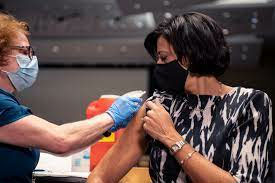FLU infections dropped by 60% after the introduction of Covid- 19 restrictions.
This reduced exposure to influenza may mean reduced population immunity. The lifting of Covid-19 controls could lead to a large flu outbreak. Anyone offered a flu vaccination should take it to reduce the risk.
A study in the Journal of Infectious Diseases has predicted a severe influenza outbreak once Covid-19 control measures are lifted, with increased levels of flu in the following years.
The researchers from Columbia University Mailman School of Health used computer modeling to quantify the reduction in transmission and incidence of flu after the implementation of control measures.
They used these data together with data from the Centers for Disease Control and Prevention (CDC) FluView websiteTrusted Source to project influenza transmission over the next 5 years.
Non-pharmaceutical interventions (NPIs), such as mask-wearing, physical distancing, travel restrictions, and school closures, led to a 60% drop in flu infections during the 10 weeks after their introduction last year.
The study suggests that the reduced exposure to flu during the control measures will have led to reduced immunity.
Stay informed with live updates on the current Covid-19 outbreak and visit our coronavirus hub for more advice on prevention and treatment.
Dr. Jonathan Stoye, head of virology at the Francis Crick Institute in London, United Kingdom, told Medical News Today: “This modeling study […] suggests that the reduced numbers of infections in 2020 will lead to waning population immunity and that this may, in turn, contribute towards a surge in flu infections for several years.”
The researchers predict that relaxing measures could lead to a large-scale flu outbreak, particularly in parts of the United States where there were high levels of COVID-19 control compliance.
They also anticipate that the low levels of flu during the pandemic may make it difficult to predict which circulating flu strains they will need to use to inform the future vaccines. This could reduce the effectiveness of influenza vaccines.
This micronutrient test checks for vitamin B12, D, E, Magnesium, Copper, Selenium & Zinc. Get your results in 2-5 days from an accredited laboratory with free shipping, Order today for 30% off.
On a more optimistic note, the authors concede that the predicted bad flu season is not inevitable.
Because of the focus on COVID-19, flu may have been underreported last year, so more people may have been exposed to the virus than their modeling recognizes.










